10
Developing Services
This chapter describes how Content Developers use the Service Designer to create and manage objects of the Oracle9iAS Wireless repository. Each section of this document presents a different topic. These sections include:
- Section 10.1, "Overview of the Service Designer"
- Section 10.2, "Logging into the Service Designer"
- Section 10.3, "Managing Master Services"
- Section 10.4, "Managing Master Alerts"
- Section 10.5, "Managing Data Feeders"
- Section 10.6, "Managing Logical Devices"
- Section 10.7, "Managing Preset Definitions"
- Section 10.8, "Managing Transformers"
- Section 10.9, "Managing Adapters"
- Section 10.10, "Setting Adapter Parameters"
- Section 10.11, "Managing Regions"
10.1 Overview of the Service Designer
The Service Designer is a Web-based interface that enables Content Developers to create the following objects:
Master Services
Master services provide the actual implementation of the service. They specify the adapter used for the service and any service-specific parameters. By mapping an adapter to device transformers, master services link Wireless content sources to delivery platforms. Each master service is based on one adapter. A master service creates its own instance of the adapter it uses. Therefore, several services can use the same type of adapter, and each can pass its own service-specific argument values.
Content Managers create services based on master services and assign them to user groups.
Async Agent Services
The Service Designer enables you to augment master services by making them accessible by protocols other than HTTP. For example, you could assign an async agent service for services accessed by users whose devices do not have a Web browser, but support two-way messaging or email.
With async agent-enables services, users can access Web content. For example, async agent services enable end users who subscribe to OracleMobile to retrieve such Web content as stock quotes, traffic reports, or horoscopes by sending a message to Ask@OracleMobile.com. The Ask listener running on the iAS Wireless Server intercepts this message, which can be either an email or a short message, routes the request to the correct service or application, and then sends the requested information back to the user.
Master Alerts
A master alert is a template for an alert, a notification service delivered to users based on the trigger conditions they set when subscribing to an alert service. Master alerts designate the data feeders used for an alert service as well as the trigger parameter definition, trigger condition definition and optionally input parameter definition for an alert service. In addition, the master alert presents a simple result XML message template.
An alert service can deliver alert messages which are drawn from data feeds on a determined value, or at a scheduled time.
The default delivery mechanism of the alert message is through the transport module. The alert engine may provide hooks to invoke a customized message delivery mechanism to handle the alert delivery event.
Data Feeder
A data feeder is a repository object that retrieves content from both internal and external content sources and then converts that content into a standard XML format. The data feeder mechanism then publishes the content to the alert engine, which formats and sends alert messages that use the content that the data feeder retrieved and rendered from the content source.
Logical Devices
A logical device is a repository object that represents either a physical device, such as an Ericsson mobile phone, or an abstract device, such as an email server. Logical devices represent the interface between transformers and the target devices or applications
Preset Definitions
Presets enable users to personalize services by defining their own input parameters for an application. When a user requests a service, an adapter loads the user-defined input parameters, or presets. The service presents these presets as a list for the user, who must then select an item to execute the application. Wireless saves users presets on a table specific to each service.
Transformers
Transformers are Java programs or XSLT stylesheets that convert a document into either the target format or to another Wireless format. Transformers not only map source tags to target format tags, but they can also manipulate content. Because transformers can rearrange, filter, and add text, you can present content in the format, as well as the form factor that is best suited for the target device.
The Wireless initial repository includes transformers for several target formats, such as CHTML, HDML, HTML, MML, VoiceXML, VoxML, and WAP (WML). By modifying the provided transformers, or by creating new ones, you can target new device platforms and optimize content presentation for specific devices. Wireless publishes device transformation rule files so that anyone can create support for any type of device and markup language.
The transformer associated with a logical device is that device's default transformer. Default transformers are typically generalized for a markup format, but they can also be specific to a target device. Wireless uses the device's default transformer to convert any service targeted for that type of device, unless a custom device transformer overrides the default transformer. A custom device transformer enables you to control how a service appears on a specific device. While several devices can use a single default transformer, a custom transformer can be associated with only one master service and one device. The custom transformer optimizes the presentation of that service for a particular device and can only be used for that device.
When you create a transformer, you map the elements in the source content to the result format.
Adapters
An adapter is a Java application that retrieves data from an external source and renders it in Wireless XML. In the Oracle9iAS Wireless architecture, adapters constitute the interface between the Wireless server and the content source. When invoked by a master service, an adapter returns an XML object that contains the service content. This XML object is processed by the core of the Wireless and then delivered to the user's device as a the response to the user's service request.
Regions
Wireless uses regions to enable developers to assign a location to a service, making the service location-based, unique to a specified area.
10.2 Logging into the Service Designer
Before using the Service Designer, you must first log into the Webtool as follows:
- Access the login page through the following URL:
http://hostname:7777/webtool/login.uix
Note:
7777 is the default port number for Oracle9iAS Wireless. The port number range is 7777 to 7877. To ensure that you are using the correct port number, check the port number for Oracle9iAS Wireless stored in [Oracle home]/install/portlist.ini. For more information on port usage, see Oracle9i Application Server Installation Guide and the Oracle9i Application Server Administrator's Guide.
|
- Enter your user name and then enter your password. If you are an administrator, enter orcladmin as your user name. (The password is set during installation, but can be changed with the User Manager.)
After you successfully login, the Service screen of the Service Designer appears with the Service Designer Tab selected. The Service Designer Tab contains the following subtabs:
- Master Services
- Data Feeders
- Master Alerts
- Data Feeders
- Logical Devices
- Preset Definitions
- Transformers
- Adapters
- Regions
The Service Designer provides a tab for each of these repository objects. Each tab has a browsing screen, which enables you to search for an object, as well as access to functions for creating, editing and deleting, and testing objects.
Figure 10-1 The Browse Folder Screen of the Service Designer's Master Service Tab
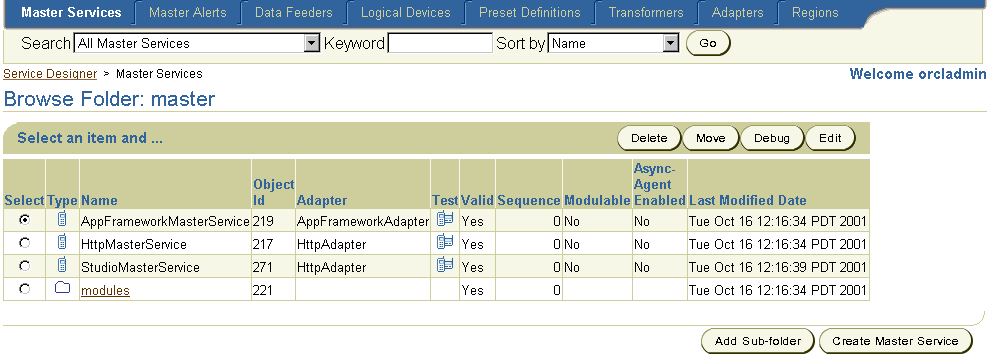
Text description of the illustration cdv_brow.gif
10.3 Managing Master Services
Selecting the Master Services tab displays the Browse Folder screen, which enables you to create, edit, delete, debug, and move master services and folders. The screen also enables you to test master service and view it on a phone simulator.
The Browse Folder screen enables you to view the top-level folders in the hierarchy, which the Service Designer displays as hyperlinks. These hyperlinks allow you to "drill down" or traverse deeper into the hierarchy with each successive click. Wireless displays the structure of the hierarchy, enabling you to see level you currently access.
The Browse Folder screen displays Wireless objects as follows:
Table 10-1 Elements of the Browse Folder Screen of the Service Designer
10.3.1 Searching for a Master Service
The Browse Folder screen of the Service Designer enables you to search for a master service using a search field in conjunction with drop-down lists of search options, which you can use to either narrow or broaden your searches. The search results display as a list on the Search Result screen.
To find an object, perform one or more of the following and then click Go.
- From the drop-down list, select one of the following options to narrow or broaden your search:
- All Master Services
- Async-Agent-Enabled Master Services
- Modulable Master Services
- Folders
- Enter a keyword.
- From the drop-down list, select one of the following sorting options for the search results:
- Name. Select this option to sort results by the name of the master service or folder.
- Last Modified Date. Select this option to sort results by the last time the object was modified.
- Click Go. The Search Result screen appears. The Search Result screen organizes objects as follows:
Table 10-2 Elements of the Search Results Screen of the Service Designer
- To return to the Browse screen, click OK.
Figure 10-2 A Search Result Display
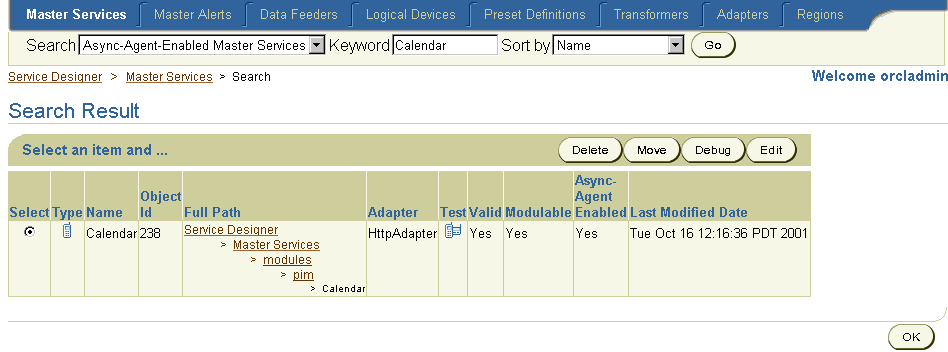
Text description of the illustration cdv_srch.gif
10.3.2 Creating a Folder
You can organize your repository objects by creating subfolders. These subfolders, which can represent topic areas, can be nested into other subfolders. When you create a subfolder, the Service Designer displays it as a hyperlink in the Browse screen. Clicking this hyperlink enables you to see the folder's contents.
To create a folder:
- From the Browse Folder screen, click the Add Sub-Folder button. The Create Folder Screen appears, displaying the following parameters:
Table 10-3 Parameters of the Create Folder Screen
- Complete the form as follows:
- Enter a name for the folder in the Name field. This is a required field.
- Enter a brief description of the folder in the Description field.
- Select the Valid check box to enable the folder.
- Enter the URI of an image used as the icon that appears on top of the screen when this folder becomes the current folder.
- Enter the URI of an image used as the icon that appears next to the folder in a menu listing.
- Enter the URI of the audio file read aloud by voice-reader software when users access a folder.
- Enter the URI of the audio file read aloud by voice-reader software along with the folder name in the menu listing.
- Click Create.
10.3.3 Creating a Master Service
The Service Designer enables you to create a master service using the Master Service Creation Wizard. This tool provides you with a separate screen for each step of the creation process.
Note:
You must follow the sequence to its end to create a master service; if you exit the wizard at any point by selecting Cancel, you lose all the values you have entered.
|
10.3.3.1 Step 1: Entering the Basic Information for the Master Service.
From the Browse Folder Screen, click Create Master Service. The Basic Information screen of the Master Service Creation Wizard appears. You use this screen to enter the configuration properties for the master service. The Screen contains the following fields:
Table 10-4 Basic Configuration Parameters for the Master Service
Enter the following in the Basic Information screen:
- Enter the name for the master service in the Name field. This is a required field.
- Enter a description for the service in the Description field.
- Select an adapter from the drop-down list. This is a required field.
Note:
The SQL adapter and the Web Integration adapter are deprecated in this release. See the Oracle9iAS Developer's Guide for more information on adapters.
|
- Select the Support Module check box if you wish to create a service that can be deployed as a module within other services.
- Select the Location-Based check box to create a service with content specific to a location.
- Click the flashlight icon to browse a list of region IDs.
- Click the appropriate region ID.
- Enter the URI of an image used as the icon that appears next to a service when this service becomes the current service.
- Enter the URI of an image used as the icon that appears next to the service in a menu listing.
- Enter the URI of the audio file read aloud by voice-reader software when users select the service from a menu.
- Enter the URI of the audio file read aloud by voice-reader software along with the service in a menu listing.
- Enter a sequence number.
- Click Next. The Caching screen appears.
Figure 10-3 The Basic Info. Screen of the Master Service Creation Wizard
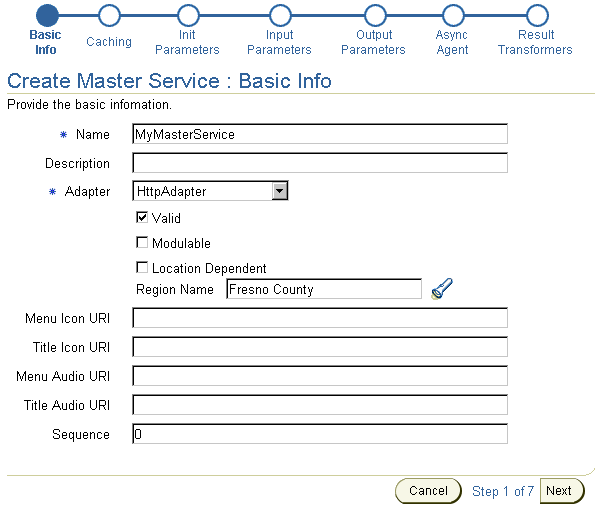
Text description of the illustration cdv_cmsb.gif
10.3.3.2 Step 2: Entering Caching Information
You select the Cacheable check box for a service with changing content. Selecting the Cacheable option saves the adapter invocation and transformation. If you create a caching master service, then you must specify the frequency at which the Wireless server notifies the cache when a Web page has changed by issuing an invalidation report. If you do not wish to create a services that can be cached, leave the Cacheable check box clear, and click Next.
To create a service that can be stored in cache:
- Select the Cacheable check box. The Invalidation Frequency section of the screen appears.
- In the Cardinal field, enter the frequency, as a number value, of the unit selected from the Unit drop-down list.
- Using the Unit drop-down list, select from among the following time units:
- Second
- Minute
- Hour
- Day
- Week
- Month
- Using the drop-down lists, select the day and time (if applicable) for the invalidation frequency.
- Click Next. The Init Parameters screen appears.
Figure 10-4 The Caching Information Screen of the Master Service Creation Wizard
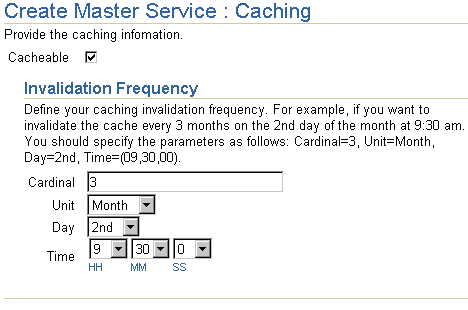
Text description of the illustration cdv_cach.gif
10.3.3.3 Step 3: Entering the Init Parameters of the Master Service
The Init Parameters screen contains the init parameters for the adapter you chose in Step 2. Not all adapters have init parameters. Enter the values for the init parameters and click Next. If the selected adapter does not contain init adapters, click Next.
Note:
The SQL adapter and the Web Integration adapter are deprecated in this release. See Section 10.10 for more information on setting the parameters for the AppsFramework adapter, the Mobile Applications Framework adapter, the SQL Adapter and the Web Integration adapter.
|
If you want to plug in a listener for such purposes as debugging, specify the listener class in the HttpAdapterInvokerListener field. These listener methods are called at the following times:
- When the HTTP adapter invocation starts.
- Before the connection to a remote .jsp
- After the connection to the remote .jsp
- At the end of the HttpAdapter invocation
- When errors occur.
Note:
You must specify the classpath in the OC4J config/application .XML file or you must copy the .jar file to wirless/lib.
|
10.3.3.4 Step 4: Selecting the Input Parameters for the Master Service
The Input Parameters Screen displays the input parameters for the adapter you selected in Step 1. The Master Service Creation Wizard queries the adapter definition to determine the parameters that appear in this screen. The input parameters for master services using the HTTP Adapter and the OC4J Adapter include the following:
Table 10-5 Input Parameters for the HTTP Adapter and the OC4J Adapter
The Input Parameters screen enables you to select an input parameter as well as add and delete input parameters to the adapter implementation for this master service.
Selecting an Input Parameter
To select an input parameter for the master service, Click on the Select radio button next to the input parameter you want to use and then click Next.
Adding a New Input Parameter to the Adapter
To add a new parameter to the adapter you selected in Step 1:
- Click Add Another Row.
- In the blank row, enter a name for the input parameter in the Name field.
- Enter a description for the input parameter in the Comment field. This can be the same information as both the Name and Caption.
- Select the Mandatory check box if this input parameter requires a value.
- Enter, if needed, a default value for the parameter. If you do not enter a default value, then Wireless prompts the user for a value.
- Click Next.
See Section 10.10 for information on the parameters for the SQL Adapter and WebIntegration Adapter.
Deleting an Input Parameter
To delete an input parameter,
- select the parameter you want to remove from the adapter implementation of this master service.
- Click Delete.
- Click Next.
Figure 10-5 The Input Parameters Screen of the Master Service Creation Wizard

Text description of the illustration cdv_inpt.gif
Setting the Input Parameters for the HTTP Adapter
The HTTP adapter retrieves remote content and delivers it as mobile XML.The input paramters for the HTTP adapter include:
Table 10-6 The Input Parameters for the HTTP Adapter
10.3.3.5 Step 5: Selecting the Output Parameters for the Master Service
The Output Parameters screen enables you to select the output parameters for the adapter selected in Step 1, or optionally add output adapters for that adapter. The Master Service Creation Wizard queries the adapter definition to determine the parameters that appear in this screen.
Note:
You do not need to define output parameters for master services using the HTTP adapter and the OC4J adapter.
|
The output parameters have the following attributes:
Table 10-7 Output Parameters for Adapters
To select an output parameter, use the radio buttons to select the appropriate output parameter and then click Apply. To delete an output parameter, select the output parameter and click the Delete button.
Adding a New Output Parameter to the Adapter
Perform the following to add a new output parameter to the adapter selected in Step 1:
- Enter a name for the output parameter in the Name field.
- Enter a description that can be used as a label for the output parameter in the Caption field.
- In the Comment field, enter a description for the output parameter that can be used internally. You can enter the same description for the Name, Caption, and Comment field.
- Select the User Customizable check box to enable the end user to edit the output parameter.
After you have finished adding or deleting the output parameters for the adapter, click Next. The Confirmation screen appears if Wireless has not found a PASection in the master service you have created. Review the values listed on the Confirmation screen. If they are correct, click the Finish button. You have completed creating a master service.
If your master service contains a PASection, the Create Result Transformer screen appears.
10.3.3.6 Step 6: Creating an Async Agent Service -- Optional
By assigning Async Agent to a master service, you create a master service that can be accessed by protocols other than HTTP.
To set the values for an Async Agent service:
- Select the Async Agent check box.
- In the Async Command Line Syntax field, enter the text that is returned when a user issues an application help command to the Async Server.
- Enter the delimiter parameters for the Async Agent service.
Note:
The space (" ") is the default delimiter.
|
- Complete the Async Service Argument List section as follows:
- Click Add Another Row.
- In the Name field, enter a name for the argument.
- Enter a number to represent the sequence in which the argument appears on the command line.
- Enter a default value for the argument. Leaving this field blank creates a service that requests a value from the user.
- Click Next.
10.3.3.7 Step 7: Selecting the Result Transformer -- Optional
After you have set the output parameters for the adapter, Wireless checks if the input parameters include PASection, the value used by the WIDL adapter to identify the service that is the entry point in the chained service sequence. If the Master Service Creation Wizard finds a PASection input adapter, it invokes the Result Transformer screen.
The transformer screen enables you to select a transformer for the adapter or add a new one by importing the XSLT stylesheet from your local file system.
Note:
You can skip this step if you selected an adapter that returns Mobile XML.
|
To select a transformer for the adapter you selected in Step 1, use the radio buttons and then click Apply. To delete a transformer from the adapter, select the transformer using the Select radio button and click Delete.
Importing an XSLT Style Sheet
- Click the tab that represents the
PASection you wish to edit. Each panel contains a text editor for entering the XSLT style sheet. You can also import an XSLT style sheet by clicking the import button.
- Click Next after you have completed editing the XSLT style sheet. The Device Transformer Screen appears. Leave this screen blank if you do not wish to create a result transformer and click Next until you reach the Confirmation screen.
- If the values appear correct, click Finish to complete the creation of the master service.
Adding a New Result Transformer
To add a new result transformer:
- Enter a name for the transformer in the Name field.
- Click the Import button to retrieve the XSLT stye sheet from your local file system. The style sheet then appears in the Content window.
- Make any needed changes to the style sheet.
- Click Add.
- Click Finish to complete the creation of the master service.
You have created a master service. This master service is not visible to users until the Content Manager publishes a service based based upon it to user groups.
10.3.4 Editing a Master Service
The Edit button in the Browse Folder screen enables you to edit the basic configuration, init parameters, input parameters, output parameters, Async Agent functions, and result transformer of a master alert.
10.3.4.1 Editing the Basic Configuration Parameters of a Master Alert
To edit a the basic configuration parameters of a master service:
- From the Browse Folder screen, select the master service you wish to edit.
- Click the Edit button. The Edit Master Service screen appears and defaults to the Basic Info. screen. The Basic Info. screen is populated with the basic configuration values set for the selected master service.
- Edit the values as needed. See Section 10.3.3.1 for information on the parameters of the Basic Info. screen.
- Click Ok to save your changes. Clicking Cancel resets the values to their original state and returns you to the Browse Folders screen.
Figure 10-6 The Basic Info. Screen for Editing Master Services

Text description of the illustration cdv_edms.gif
10.3.4.2 Editing the Caching of a Master Service
To edit the caching information for a the selected master service:
- Select Caching from the left menu.
- The Edit Cache screen appears.
- Edit the values as needed. See Section 10.3.3.2 for information on entering caching information.
- Click OK to save your changes. Clicking Cancel resets the values to their original state and returns you to the Browse Folders screen.
Figure 10-7 The Edit Cache Screen
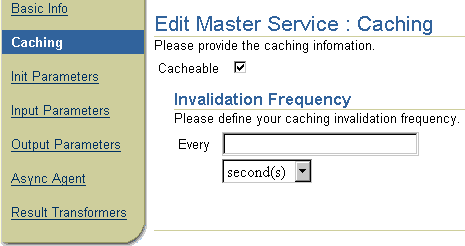
Text description of the illustration cdv_emch.gif
10.3.4.3 Editing the Init Parameters of a Master Service
To edit the init parameters of a master service:
- Select Init Parameters from the left menu. The Edit Init Parameters screen appears, displaying the values set for the init parameters of the selected service.
- Edit the values for the init parameters as needed. See Section 10.3.3.3 for more information on the parameters of the init parameters.
- Click OK to save your changes and select. Clicking Cancel resets the values to their original state and returns you to the Browse Folders screen.
10.3.4.4 Editing the Input Parameters of a Master Service
To edit the input parameters of a master service:
- From the Edit Master Service screen, select Input Parameters from the left menu. The Edit Input Parameters screen appears, displaying the values set for the input parameters of the selected service.
- Edit the values for the input parameters as needed. See Section 10.3.3.4 for more information on the input parameters.
- Click Ok to save your changes. Clicking Cancel resets the values to their original state and returns you to the Browse Folders screen.
10.3.4.5 Editing the Output Parameters of a Master Service
To edit the output parameters of a master service:
- From the Edit Master Service screen, select Output Parameters from the left menu.
- The Edit Output Parameters screen appears, displaying the values set for the output parameters of the adapter used by selected service.
- Edit the values for the output parameters as needed. See Section 10.3.3.5 for more information on the output parameters.
- Click OK to save your changes. Clicking Cancel resets all values to their original state and returns you to the Browse Folders screen.
10.3.4.6 Editing an Async Agent Service
To edit an Async Agent service:
- Select Ask Service from the menu in the Edit Master Service screen. The Edit Ask Service screen appears, displaying the values set for the parameters of the selected master service.
- Edit the values for the Async Agent parameters as needed. See Section 10.3.3.6 for more information on the Async Agent parameters.
- Click OK to save your changes. Clicking Cancel sets all the values you have entered back to their original state and returns you to the Browse Folders screen.
10.3.4.7 Editing the Result Transformer for a Master Service
To edit the result transformer:
- From the Edit Master Service screen, select Result Transformer from the left menu. The Edit Result Transformer screen appears, displaying the result transformer's XSLT style sheet for the adapter used by selected service.
- Edit the entries as needed. See Section 10.3.3.7 for more information on setting the values for the result transformer and importing a XSLT stylesheet.
- Click OK to save your changes. Clicking Cancel sets all the values to their original state and returns you to the Browse Folder screen.
10.3.5 Deleting a Master Service
To delete a master service:
- From the Browse Folders screen, select the master service you wish to delete.
- Click Delete.
10.3.6 Debugging Master Services
The Service Designer enables you to simultaneously view a master service on a phone simulator and in Wireless XML or device markup languages.
Transformers, in the form of XSLT stylesheets or Java classes, convert the content returned by Wireless adapters into the format best suited to a particular platform.
To test a service:
- From the Browse Folders and Services screen, select a master service.
- Click Debug. The Debug Service screen appears.
- Select from among the following output formats:
- Adapter XML Result
Selecting this result type enables you to see Wireless source content in the AdapterResult format, the intermediary format between the source and the target output device. Source content in the AdapterResult format must be converted into SimpleResult format before it can be delivered to a target device. If no text displays in the The Result panel, then no AdapterResult has been produced.
- Wireless XML Result
Selecting Wireless XML Result displays the source content in Wireless' SimpleResult format of the output that is returned by an adapter.
- Device Result
The DeviceTransformer drop-down menu lists the logical devices in the repository. Selecting a logical device enables you to see the final markup language for that device.
- Click Set Parameters.
- Click Run Service. The service appears on a phone simulator. The selected result appears in the Service Result window.
Setting the Display Length of the Logging File
The System Log section enables you to set the number of lines from the end of the server's system log file that you want to see.
To set the number of lines from the server: displays from the end of the system log.
- Enter the number of lines from the end of the system log that you want to review:
- Click Refresh Log. The specified number of lines from the end of the system log appear.
- Click Done.
10.3.7 Moving Folders and Master Services
The Service Designers Move function enables you to organize your master services and folders.
To move a master service:
- From the Browse screen, select the folder or master service you wish to move. Click Move. The Move screen appears.
- Select a new location for the folder or master service from the list in the Move screen.
- Click Move Here.
10.4 Managing Master Alerts
The Alerts tab of the Service Designer enables you to create, edit and delete master alerts. When you select the Alerts tab, the Browse Alerts screen appears, displaying a list of the current master alerts. The Browse screen organizes the master alerts as follows:
Table 10-8 Element of the Browse Master Alerts Screen
Figure 10-8 The Browse Master Alerts Screen

Text description of the illustration cdv_albr.gif
10.4.1 Creating a Master Alert
The Master Alert Creation Wizard steps you through the creation of a master alert. This wizard, invoked by clicking the Create Master Alert button in the Browse Master Alerts screen, provides a separate screen for each step of the process.
Once you have created a master alert, a user with the System role this master alert to an alert engine process. The master alert becomes active once the Sytstem manager starts the both alert engine process and the data feeder engine process.
10.4.1.1 Step 1: Entering the Basic Configuration Parameters for the Master Alert
You enter the basic configuration parameters for the master alert in the Basic Info. screen, the first in the master alert creation sequence.
Figure 10-9 The Basic Info Screen of the Master Alert Creation Wizard
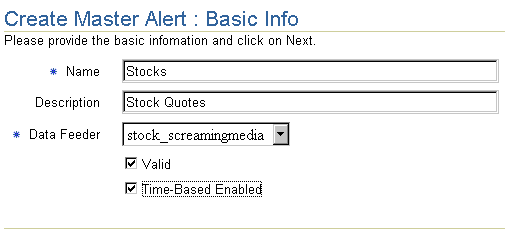
Text description of the illustration cdv_bsal.gif
The Basic Info. screen includes the following parameters:
Table 10-9 Basic Configuration Parameters for a Master Alert
To enter the basic configuration parameters for the master alert:
- Enter the name for the master alert in the Name field.
- Enter a short description for the master alert in the Description field.
- Using the drop-down list in the Data Feed field, select a data feed source for the master alert.
- Select the Time-Enabled check box to designate the master alert as displaying at a predetermined time.
- Click Next. The Trigger Conditions screen appears.
Figure 10-10 The Trigger Conditions Screen of the Master Alert Creation Wizard
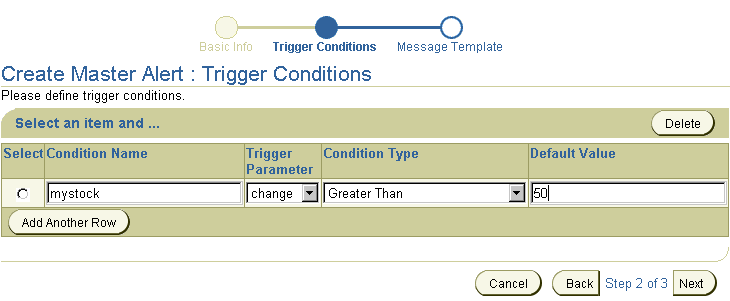
Text description of the illustration cdv_tral.gif
10.4.1.2 Step 2: Setting the Trigger Conditions for the Master Alert
You use the Trigger Condition screen to enable end users to set the conditions that invoke an alert on end users' devices. For example, if you create an alert notifying users of a stock price, you can to set the alert conditions that allow an end user to request a notification when the stock has risen above, or fallen below, a certain price.
The Trigger Condition screen includes the following parameters:
Table 10-10 Trigger Conditions for Master Alerts
Selecting a Trigger Condition
To select a trigger condition:
- From the list of trigger conditions, select the trigger condition.
- Edit the Condition Type, Trigger Parameter, or Default Value fields as needed.
- Click Apply.
Adding a New Trigger Condition
To add a new Trigger Condition
- Enter the name for the trigger condition in the Condition field.
- Enter text used for prompting input from end users in the Caption field.
- Select a trigger parameter from the drop-down list in the Trigger Parameter field.
- Select a Condition Type from the drop-down list in the Condition Type field. Condition types depend on the data type of the trigger parameter.
If the data type is a number, then the conditions include:
- Less Than
- Greater Than
- Equal
- Less Than and Equal
- Greater Than and Equal
- Less Than Absolute Value
- Greater Than Absolute Value
- Equal Absolute Value
- Less Than and Equal Absolute Value
- Greater Than and Equal Absolute Value
- Value Change (The condition value for this type can only be 0 or 1, where 0 means no trigger and 1 means trigger when value changes. The default value is 0.)
If the data type is text, then the condition types include:
- Exact Match
- Not Match
- Contain
- Not Contain
- Begin With
- End With
- Value Change (The condition value for this type can only be '0' or '1', where 0 means no trigger and 1 means trigger when value changes. The default value is 0.)
- Enter a default value for the trigger condition in the Default Value field.
- Click Add.
- Click Next. The Message Template screen appears.
10.4.1.3 Step 3: Creating the Message Template for the Master Alert
The Message Template screen allows you to either import a message template or provide a hook.
The data feeder output values are the dynamic values in the SimpleText stylesheet. The following stylesheet represents these values as &price and &change.
<SimpleText> Stock Alert for [&sym;]: Price: &price; Change: &change;</SimpleText>
Figure 10-11 The Message Template Screen of the Master Alert Creation Wizard
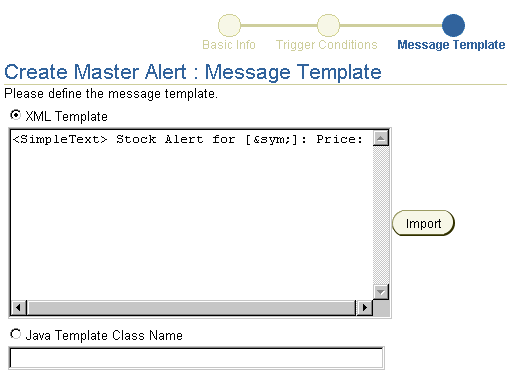
Text description of the illustration cdv_tmal.gif
Importing a Message Template
To import a message template:
- Select the Message Template radio button.
- Click Import to retrieve a message template from your local file system.
- Click Next to complete the creation of the master alert.
Note:
Wireless will not commit any of the values you have entered until you have completed the entire wizard.
|
Providing a Hook
To create a message template by providing a programming hook:
- Select Java Template Class Name.
- Enter the name of the hook.
- Click Next to complete the creation of the master alert.
10.4.2 Editing a Master Alert
The Edit button in the Browse Master Alerts screen enables you to edit the basic configuration parameters, trigger conditions, and message template for a master alert.
10.4.2.1 Editing the Basic Configuration Parameters of a Master Alert
To edit the basic configuration parameters of a master alert:
- From the Browse Master Alerts screen, select the master alert you wish to edit.
- Click Edit. The Basic Info. screen for editing a master alert appears, with its fields populated by the values set for the selected master alert.
- Edit the basic configuration values as needed. See Section 10.4.1.1 for more information on the basic configuration parameters of a master alert.
- Click OK to save your changes. Click Cancel to set the values back to their original state and return to the Browse Master Alerts screen.
Figure 10-12 The Basic Info. Screen for Editing a Master Alert

Text description of the illustration cdv_emal.gif
10.4.2.2 Editing the Trigger Conditions of a Master Alert
To edit the trigger conditions of a master alert:
- From the left menu, select Trigger Conditions. The Edit Trigger Conditions screen appears with its fields populated by the values set for the selected master alert.
- Edit the values as needed. See Section 10.4.1.2 for information on the parameters for the trigger conditions.
- Click OK to save your changes. Clicking Cancel sets all the values back to their original state and returns you to the Browse Folders screen.
10.4.2.3 Editing the Message Template of a Master Alert
To edit the message template of a master alert:
- From the left menu, select Message Template. The Edit Message Template screen appears with the XML template, or the Java class name set for the selected master alert.
- Perform any of the following operations:
- Edit the XML template, or import a template.
- Enter a Java template class name.
See Section 10.4.1.3 for information on the message template for a master alert.
10.5 Managing Data Feeders
The Service Designer's Data Feeder tab enables you to create, edit, and delete data feeders, Wireless object that download data from an internal or external content source and converts that data into a common format for Wireless mobile alerts.
Figure 10-13 The Browse Data Feeders Screen

Text description of the illustration cdv_dfbr.gif
Clicking the Data Feeders tab displays the browse data feeders screen, which lists the current data feeders. The Browse Data Feeders screen displays the data feeders as follows:
Table 10-11 Elements of the Browse Data Feeders Screen
10.5.1 Creating a Data Feeder
You create data feeders with the Data Feeder Creation Wizard. This wizard, invoked by clicking the Create Data Feeder button in the Browse Data Feeders screen, steps you through the creation of a data feeder by providing a separate screen for each phase of the process.
Once you create a data feeder, you can assign it to a master alert. A data feeder (and consequently the alert that derives its content using the data feeder) cannot become active until a user with the System role assigns it to a configured data feeder process and then starts the process.
10.5.1.1 Step 1: Entering the Basic Information for the Data Feeder
The Basic Info screen of the Data Feeder Creation Wizard enables you enter the basic properties for the data feeder.
Figure 10-14 The Basic Info. Screen of the Data Feeder Creation Wizard
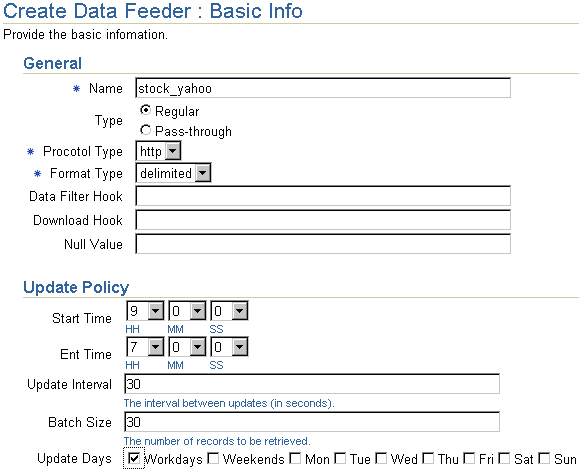
Text description of the illustration cdv_bsdf.gif
The Basic Info. screen of the Data Feeder Creation Wizard includes the following parameters.
Table 10-12 Parameters of the Basic Info. Screen of the Data Feeder Creation Wizard
Complete the Basic Info. screen as follows:
- Enter the Name of the data feeder
- Select from between the following types:
- Regular (Select if you use the built in data retrieval framework.)
- Pass-Through (Select if you use a push application to deliver data.) You must provide a Java class if you select this option.
- Using the drop-down list, select one of the following protocol types:
- http -- HTTP. The data feeder constructs the URL, performs the GET/POST on the remote Web site and authenticates if necessary
- file -- Local File. The data feeder reads a file in the file system.
- ftp -- FTP. The data feeder connects to the remote Web server, and then authenticates and downloads files. Requires a username and password.
- sql -- SQL Database. The data feeder runs a SQL query against the specified data feed and reads the output.
- app -- Local Application. The data feeder runs an application as a subprocess and then reads the .stdout file
- From the drop-down list, select on of the following format types for the retrieved content:
- delimited -- Parses delimited text. The default delimiter is the comma (,).
- fixed -- Fixed Column Text. Parses text delimited by fixed column positions.
- XML -- The preferred input format.
- Enter a data filter. For example, enter a Java class name.
- Enter a download hook. For example, enter a Java class name.
- Enter a null value to represent inapplicable data. For example, enter n/a or N/A.
- Using the drop-down menus, enter a start time for data update.
- Using the drop-down menus, enter an end time for the data update.
- Enter the number of seconds between downloads. Set this value to 0 If you want only one download interval per day.
- Enter the batch size for the download. If you set the size to one, Wireless downloads one parameter at for each HTTP request; if you set the size to ten, Wireless downloads ten parameters for each HTTP request.
- Select the day or days for the download.
- Click Next. The Init Parameters screen appears, displaying init parameters for the protocol type you selected.
10.5.1.2 Step 2: Entering the Init Parameters for the Data Feeder
The Init Parameters screen displays the init parameters specific to the protocol and format type you selected in Section 10.5.1.1.
Table 10-13 Init Parameters for Data Feeder Protocols
10.5.1.3 Entering the Init Parameters for the HTTP Protocol
To enter the init parameters for a data feeder using the HTTP protocol and the XML format type:
- Enter the HTTP URI of the content source.
- Enter a user name.
- Enter a password.
- Select either the GET or POST HTTP methods.
- If the feed ingests XML, then you must import an XSL stylesheet that converts the XML to standard feed XML format.
- Click Next. The Input Parameters screen appears.
To Enter Init Parameters for a data feeder using the HTTP Protocol and the delimited format:
- Enter the HTTP URI of the content source.
- Enter a user name.
- Enter a password.
- Enter the delimiter for the format type. For example, enter a comma (,).
- Enter a quote character for the format type you selected. For example, enter quotation marks (").
- Click Next. The Input Parameters screen appears.
To Enter the Init Parameters for a data feeder using the HTTP protocol and the fixed column format:
- Enter the HTTP URI of the content source.
- Enter a user name.
- Enter a password.
- Select either the GET or POST HTTP methods.
- Click Next. The Input Parameters screen appears.
10.5.1.4 Entering the Init Parameters for the File Protocol
To enter the init parameters for a data feeder using the file protocol and the XML format:
- Enter the file path. For example, enter c:\temp\file.txt.
- If the feed ingests XML, then you must import an XSL stylesheet that converts the XML to standard XML.
- Click Next. The Input Parameters screen appears.
To enter the init parameters for a data feeder using the file protocol with the delimited format:
- Enter the file path.
- Enter the delimiter for the format type. For example, enter a comma (,).
- Enter a quote character for the format type you selected. For example, enter quotation marks (").
- Click Next. The Input Parameters screen appears.
To enter the init parameters for a data feeder using the file protocol and the fixed column format:
- Enter the file path.
- Click Next. The Input Parameters screen appears.
10.5.1.5 Entering the Init Parameters for the FTP Protocol
To enter the init parameters for a data feeder using the FTP protocol and the XML format:
- Enter the FTP URI.
- Enter the username.
- Enter the password.
- Select either the Text or Binary FTP mode.
- If the feed ingests XML, then you must import an XSL stylesheet that converts the XML to standard XML.
- Click Next. The Input Parameters screen appears.
To enter the init parameters for a data feeder using the FTP protocol and the delimited format:
- Enter the FTP URI.
- Enter the username.
- Enter the password.
- Select either the Text or Binary mode.
- Enter the delimiter for the format type. For example, enter a comma (,).
- Enter a quote character for the format type you selected. For example, enter quotation marks (").
- Click Next. The Input Parameters screen appears.
To enter init parameters for a data feeder using the FTP protocol and the fixed column format:
- Enter the FTP URI.
- Enter the username.
- Enter the password.
- Select either the Text or Binary FTP mode.
- Click Next. The Input Parameters screen appears.
10.5.1.6 Entering the Init Parameters for the SQL Protocol
To enter the init parameters for a data feeder using the SQL protocol and the XML format:
- Enter the connect string.
- Enter a SQL query.
- If the feed ingests XML, then you must import an XSL stylesheet that converts the XML to standard XML.
- Click Next. The Input Parameters screen appears.
To enter the init parameters for a data feeder using the SQL protocol and the delimited format:
- Enter the connect string.
- Enter a query.
- Enter the delimiter for the format type. For example, enter a comma (,).
- Enter a quote character for the format type you selected. For example, enter quotation marks (").
- Click Next. The Input Parameters screen appears.
To enter the init parameters for a data feeder using the SQL protocol and the fixed column format:
- Enter the connect string.
- Enter a query.
- Click Next. The Input Parameters screen appears.
10.5.1.7 Entering the Init Parameters for the Application Protocol
To enter the init parameters for a data feeder using the application protocol and the XML format:
- Enter the command line.
- If the feed ingests XML, then you must import an XSL stylesheet that converts the XML to standard XML.
- Click Next. The Input Parameters screen appears.
To enter the init parameters for a data feeder using the application protocol and the delimited format:
- Enter the command line.
- Enter the delimiter for the format type. For example, enter a comma (,).
- Enter a quote character for the format type you selected. For example, enter quotation marks (").
- Click Next. The Input Parameters screen appears.
To enter init parameters for a data feeder using the application protocol with the fixed column format:
- Enter the command line.
- Click Next. The Input Parameters screen appears.
10.5.1.8 Step 3: Entering the Input Parameters for the Data Feeder
The Input Parameters enables you to enter the input parameters for the data feeder. The input parameters screen displays the input parameters specific to the format type you selected in Section 10.5.1.1.
The data feeder input parameters include the following:
Table 10-14 Data Feeder Input Parameters
To enter the input parameters:
- Click Add Another Row. A row appears.
- Complete the row as follows:
- Enter the internal name.
- Enter the data type.
- Enter the external name.
- Enter the column number. This parameter is specific to the delimited format.
- Enter the starting position. This parameter is specific to the fixed-column format.
- Enter the ending position. This parameter is specific to the fixed-column format.
- Enter a caption.
- Enter a default value.
- Click Next. The Output Parameters screen appears.
10.5.1.9 Step 4: Entering the Output Parameters for the Data Feeder
The Output Parameters screen enables you to enter the output parameters for the data feeder. The output parameters screen displays parameters specific to the format type you selected in Section 10.5.1.1.
The output parameters are the retrieved data from the content provider; you set alerts on the output parameters of a data feeder.
The data feeder output parameters include the following:
Table 10-15 Data Feeder Output Parameters
To enter the input parameters:
- Click Add Another Row. A row appears.
- Complete the row as follows:
- Enter the internal name.
- Select the data type.
- Enter the external name.
- Enter the column number. This parameter is specific to the delimited format.
- Enter the starting position. This parameter is specific to the fixed-column format.
- Enter the ending position. This parameter is specific to the fixed-column format.
- Enter a caption.
- Click Finish to complete the data feeder. The Browse Data Feeder screen reappears, displaying the new data feeder.
10.5.2 Editing a Data Feeder
The Edit button in the Browse Data Feeder screen enables you to edit the basic configuration, init parameters, input parameters, and output parameters of a data feeder.
10.5.2.1 Editing the Basic Configuration of a Data Feeder
To edit the basic configuration of a data feeder:
- From the Browse Data Feeders screen, select the data feeder that you wish to edit.
- Click Edit.
- The screen for editing the basic configuration of the data feeder appears, with its fields populated by the values set for the selected data feeder.
- Edit the values as needed. See Section 10.5.1.1.for more information on the basic configuration parameters of a data feeder.
- Click OK to save your changes. Clicking Cancel resets the basic configuration values back to their original state and returns you to the Browse Data Feeders screen.
10.5.2.2 Editing the Init Parameters of a Data Feeder
To edit the init parameters of a data feeder:
- From the menu, select Init Parameters. The screen for editing init parameters appears, populated with the init parameters set for the selected data feeder.
- Edit the init parameters as needed. See Section 10.5.1.2 for more information on the init parameters of a data feeder.
- Click OK to save your changes. Clicking Cancel resets the values for the init parameters back to their original state and returns you to the Browse Data Feeders screen
10.5.2.3 Editing the Input Parameters of a Data Feeder
To edit the output parameters of a data feeder:
- From the menu, select Input Parameters. The screen for editing the input parameters appears, populated with the values set for the selected data feeder.
- Edit the values as needed. See Section 10.5.1.8 for more information on the input parameters of a data feeder.
- Click OK to save your changes. Clicking Cancel sets the input parameters to their original state and returns you to the Browse Data Feeders screen.
10.5.2.4 Editing the Output Parameters of a Data Feeder
To edit the output parameters of a data feeder:
- From the menu, select Output parameters. The screen for editing the output parameters appears, populated with the values set for the selected data feeder.
- Edit the values as needed. See Section 10.5.1.9 for more information on the output parameters of a data feeder.
- Click OK to save your changes. Clicking Cancel sets the output parameters back to their original state and returns you to the Browse Data Feeder screen.
10.6 Managing Logical Devices
A logical device is an object in the Wireless repository that represents either a physical device, such as a Nokia mobile phone, or an abstract device, such as email. Logical devices represent the interface between Wireless transformers and the target devices or applications.
Wireless determines the type of device that is requesting a service from the HTTP header. A device agent identifies the user's device address, such as an email address or telephone number and device type. This information enables Wireless to deliver notifications to the user.
You use the Logical Devices tab to create a logical device in the repository. When you click the Logical Device tab, the Browse Logical Devices screen appears, displaying a list of logical devices in the repository. Using the Browse Logical Device screen, you can search for, create, delete, and edit the user agents of a logical device.
Figure 10-15 The Browse Logical Devices Screen
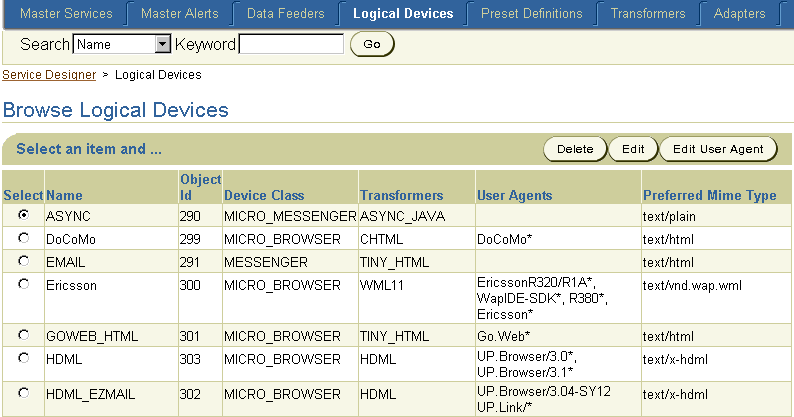
Text description of the illustration cdv_brlo.gif
10.6.1 Searching for a Logical Device
From the Browse screen, you can search for logical devices using the Keyword field. You can sort your search results by name, user agents, or transformers. .
To search for a logical device:
- Select, if needed, one of the following search result sorting options:
- Name
- Transformers
- User Agents
- Enter the keyword for your search.
- Click Go. The Search Results screen appears. To return to the Browse screen, click OK.
Figure 10-16 The Search Results Screen (for Logical Devices)

Text description of the illustration cdv_sldv.gif
10.6.2 Creating a Logical Device
You create a logical device using the logical device creation wizard. The logical device creation wizard guides you through each step of creating a logical device. When you complete a screen, you move to the next screen in the sequence by clicking the Next button. Clicking the Back button takes you to the preceding screen in the sequence, allowing you to perform edits.
10.6.2.1 Step 1: Entering the Basic Information for the Logical Device
- From the Browse Logical Devices screen, click Create Logical Device. The Basic Info. screen appears displaying the following parameters:
Table 10-16 Parameters of the Logical Device Creation Wizard Basic Information Screen
- Enter the name of the logical device into the Name field. This name must be unique. For example, enter Email.
- Enter, if needed, a desciption of the device.
- Enter the content encoding parameters for the logical device. For example, enter UTF-8.
- Enter the MIME type in the MIME field. For example, enter text/html.
- From the Device Class drop-down list, select the appropriate display size of the user's device.
- Enter the prolog required by the device.
- Click Next. The Transformers screen appears.
10.6.2.2 Step 2: Selecting the Appropriate Transformers
- From the Transformer screen, select transformers appropriate to the MIME type of the logical device from Eligible Transformers to Selected Transformers using the Move functions (>>or >>). Use the Remove functions (<< or <<) to remove the transformers you do not wish to use from Selected Transformers.
- Click Next.
10.6.2.3 Step 3: Adding User Agents
The User Agent screen enables you to assign a user agent to the logical device by selecting from a list of user agents, mechanisms that identify device type and address.
To add a user agent.
- Enter the user agent name. For example, enter WIG Browser/1.1*
- If needed, click Add Another Row to add another user agent.
- Click Next. The Device Attributes screen appears, displaying the following parameters:
Table 10-17 Parameters of the Device Attributes Screen
10.6.2.4 Step 4: Setting the Device Attributes for the Logical Device
Complete the Device Attributes screen as follows:
- Enter the Maximum Native Document Size.
- Set the display properties as follows:
- Enter the points for the screen width.
- Enter the points for the screen height.
- Enter the number of screen columns.
- Enter the number of rows.
- Enter the number of softkeys that the end user can use to create short-cuts.
- Select the Color Capable check box if the device supports color.
- Enter the number of bits per pixel.
- Select the Voice Capable check box if the device supports audio.
- Select the Image Capable box if the device supports images.
- Use the Move functions (> or >>) to select the preferred image formats from Available Formats. Use the Remove functions (< or <<) to remove the image formats you do not wish to use from Preferred Formats.
- Select the Video Capable check box if the device supports video.
- Select this check box for a device that supports video. Use the Move functions (>or >>) to select the preferred video formats from Available Formats. Use the Remove functions (< or <<) to remove the video formats you do not wish to use from Preferred Formats.
- Select the Streaming option for real-time video. You can only select this option if you have selected Video Capable.
- Select the Buffered option for storing bits of incoming video data before playing them. Using this option ensures a smooth presentation, one in which users see all frames. You can only select this option if you have selected Video Capable.
- Click Next. The User Agents screen appears.
10.6.2.5 Step 5: Creating the Login Page
The Login Page screen enables you to create the XSLT stylesheet that generates the login page on the device.
- Provide a stylesheet using one of the following methods:
- Enter the XSLT stylesheet manually into the Login Page field.
- Copy the XSLT stylesheet from a text editor into the Login Page field.
- Import the XSLT stylesheet by clicking Import. In the Import screen, enter the name of the file in the Import File field and then click Import, or retrieve the file using the Browse function and the Upload window. After you select the file, Click Open. From the Import Screen, click Import.
- Click Next. The Error Page screen appears.
10.6.2.6 Step 6: Creating the Error Page
The Error Page screen enables you to create an XSLT stylesheet that generates the error page for the device.
- Provide a stylesheet using one of the following methods:
- Enter an XSLT stylesheet manually into the Login Page field.
- Copy an XSLT stylesheet from a text editor into the Login Page field.
- Import the XSLT stylesheet by clicking Import. In the Import screen, enter the name of the file in the Import File field and then click Import, or retrieve the file using the Browse function and the Upload window. After you select the file, Click Open. From the Import Screen, click Import.
- Click Finish to complete the logical device.
10.6.3 Modifying a Logical Device
The Wireless Service Designer enables you to modify a logical device in the repository. To modify a logical device:
- From the Browse Logical Device screen, select the logical device you wish to edit.
- Click Edit. The Edit Logical Device screen appears. From the left menu, select the component of the logical device you wish to edit. For information on setting the values for the basic information of a logical device, see Section 10.6.2.1. See Section 10.6.2.2 for information on selecting transformers. See Section 10.6.2.4 for setting the device attributes. See Section 10.6.2.3 for selecting or adding user agents. For information on creating a login page, see Section 10.6.2.5. See Section 10.6.2.6 for information on creating the error page.
- Click OK to commit your changes.
10.6.4 Deleting a Logical Device
To delete a logical device from the repository:
- From the Browse Logical Device screen, select the logical device.
- Click Delete.
10.7 Managing Preset Definitions
Preset definitions enable users to personalize services by entering their own input parameters to an application. When a user requests a service, a service loads the user-defined input parameters, (or presets). Typically, the service may list these presets for the user, who must select an item to execute the application.
.
Note:
Preset definitions are accessible to all users in a user group.
|
Figure 10-17 The Browse Preset Definitions Screen
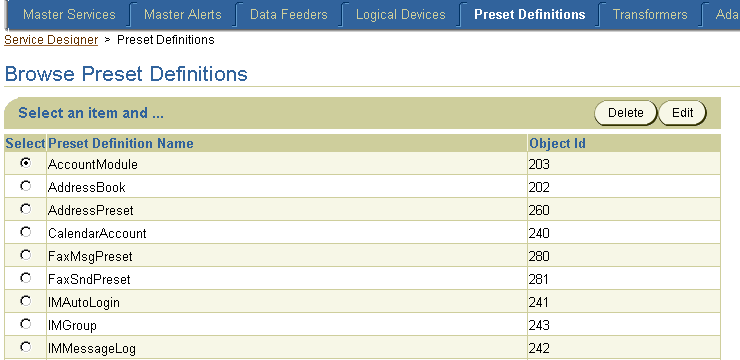
Text description of the illustration cdv_psbr.gif
When selected, the Preset Definitions tab defaults to the Browse Preset Definitions Screen, which displays a list of the current preset definitions. From this screen, you can create, edit, and delete a preset definition.
The Browse Preset Definitions screen includes the following parameters.
Table 10-18 Parameters of the Browse Preset Definitions Screen
10.7.1 Creating a Preset Definition
The Service Designer enables you to create a preset definition, a template which enables users to add values to each pre-defined preset definition. When users invoke a service, they select a value from any of the preset definitions as an input parameter.
To create a new preset definition:
- From the Browse Preset Definitions screen, click Create Preset Definition. The Create Preset Definition screen appears.
- In the General section of the Create Preset Screen, enter a name for the preset definition in the Preset Definition Name field. This is a required field.
Note:
The Preset Definition Name must be unique.
|
- Click Finish. The Browse Preset Definitions screen reappears, displaying the new preset definition.
10.7.1.1 Adding Preset Attributes
Preset attributes enable you to define the relation of input parameters that an end user can enter and save on the Wireless server.
To add Preset Attributes to your preset definition:
- In the Preset Attributes section of the Create Preset Definition screen, click Add Another Row. A blank row appears which includes the following parameters.
Table 10-19 Preset Description Parameters
- Enter the name of the preset attribute.
- Enter the value format.
- Select a column type.
- Select from among the following entry types:
- SingleLine
- MultiLine
- Enum -- If you select this option, use must define the enumeration conditions. See Section 10.7.2.1. for information on enumeration options.
- Click Finish. Clicking Cancel clears all values and returns you to the Browse Preset Definitions screen.
You can add several rows of preset attributes to define relationships, such as Name, Street Address, Phone Number.
Figure 10-18 The Create Preset Definition Screen
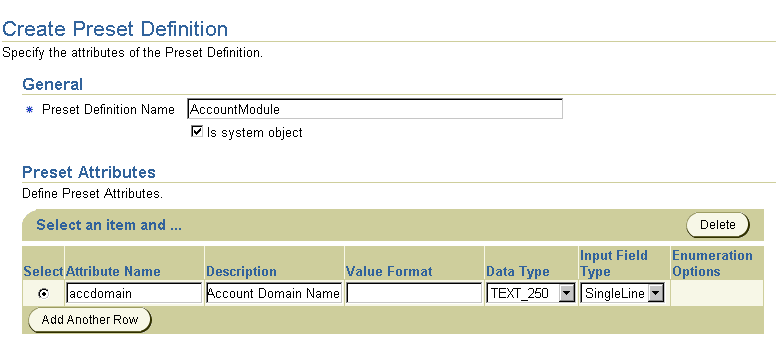
Text description of the illustration cdv_cpsd.gif
10.7.2 Editing a Preset Definition
To edit a preset definition:
- From the Browse Screen, select the preset definition that you wish to edit. Click Edit. The Edit Preset Definition screen appears.
- Edit the preset definition as needed. See Section 10.7.1.1 for information on Preset Descriptors.
- Click OK to commit your changes. The Browse Preset Definitions screen reappears.
10.7.2.1 Adding, Editing, and Deleting Preset Attribute Enumeration Options
You can edit, add, or delete a preset attribute enumeration option by using the Edit Preset Descriptor Enumeration Options screen.
To edit a preset descriptor enumeration option:
- In the Preset Descriptors section of either the Create Preset Definitions screen or the Edit Preset Definitions screen, select Enum.
- Click Edit. The Edit Preset Descriptor Enumeration Options screen appears.
- In the Description Enumeration Options screen, perform the following operations as needed:
- From the drop-down list, select the option you wish to edit or delete.
- Click add to add a new enumeration option.
- Click Done. The Create Preset Definition screen or the Edit Preset Definition screen reappears.
10.7.3 Deleting a Preset Definition
To delete a preset definition:
- From the Browse Preset Definitions screen, select the preset definition you wish to delete.
- Click Delete.
10.8 Managing Transformers
You use the Browse Transformer screen of the Transformer tab to create, edit, and delete transformers in the repository.
Figure 10-19 The Browse Transformers Screen (Partial View)

Text description of the illustration cdv_brtr.gif
10.8.1 Creating a New Transformer
To create a new transformer:
- From the Browse Transformer page, click Create Transformer. The Create Transformer screen appears and displays the following parameters:
Table 10-20 Transformer Parameters
- Enter the name of the transformer in the Name field.
- Select the MIME type that you want to use.
- If you select an XSL transformer, you can do one of the following:
- Type the code for the XSL stylesheet in the field next to the Stylesheet parameter, then click Finish.
- Using a text editor, open an existing XSL stylesheet, copy and past the lines that you want to use and then click Finish.
- Click the Import button to import an existing XSL stylesheet. The Import Transformer XSL Stylesheet appears.
Click Browse to find the XSL file that you want to use. Import the file by clicking Import. In the Import screen, enter the name of the file in the Import File field and then click Import, or retrieve the file using the Browse function and the Upload window. After you select the file, Click Open. From the Import Screen, click Import.
- If you select Java Transformer, then enter the class name of the transformer, then click Finish.
Figure 10-20 The Create Transformer Screen

Text description of the illustration cdv_ctrn.gif
10.8.2 Editing a Transformer
To edit a transformer:
- From the Browse Transformer screen, select the transformer you wish to edit.
- Click Edit. The Edit Transformer Screen appears, displaying the values set for the selected Transformer. The Edit Transformer screen includes the following parameters:
- Edit the parameters as needed. See Section 10.8.1 for information on entering values and preparing style sheets.
- Click Done to commit your changes.
10.8.3 Deleting a Transformer
To delete a transformer:
- From the Browse Transformer screen, select the transformer you wish to delete.
- Click Delete.
10.9 Managing Adapters
Selecting the Adapters tab invokes the Browse Adapters screen. You use this screen to create, edit, delete adapters.
Figure 10-21 Partial View of the Browse Adapters Screen
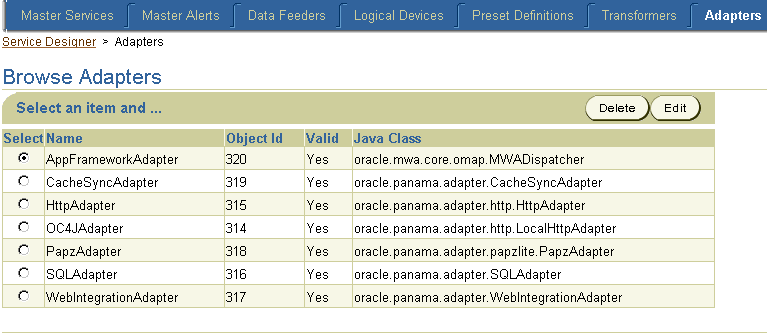
Text description of the illustration cdv_brad.gif
10.9.1 Creating an Adapter
To create an adapter:
- From the Browse Adapters screen, click Create Adapter. The Create Adapter screen appears displaying the following parameters:
Table 10-21 Adapter Parameters
- Enter a unique name for the adapter in the Name field.
- Select the Valid check box to make the adapter available to services. Leaving the Valid check box clear makes the adapter unavailable and renders all services using it invalid.
- Enter the name of the Java class, or click Import to browse and retrieve the archived class or classes that implement the adapter.
- Click Create. The Browse Adapters screen reappears, displaying the new adapter. Clicking Cancel clears any values entered and returns you to the Browse Adapters screen.
10.9.2 Editing an Adapter
To edit an adapter:
- From the Browse Adapters screen, select the adapter you wish to edit.
- Click Edit. The Edit Adapters screen appears, displaying the values for the selected adapter.
- Edit the values for the selected adapter as needed. See Section 10.9.1 for information on the adapter parameters.
- Click Done to Commit your changes. The Browse Adapters screen reappears. Clicking Cancel clears any values entered and returns you to the Browse Adapters screen.
10.9.3 Deleting an Adapter
To delete an adapter:
- From the Browse Adapters screen, select the adapter you want to delete.
- Click Delete.
10.10 Setting Adapter Parameters
The following sections describe the uses and parameters of the Wireless adapters.
10.10.1 Setting Init Parameters for Adapters
The Init Parameters screen of the Master Service Creation Wizard shows the initialization parameters for the selected adapter. These parameters vary depending on the adapter implementation. When Wireless first invokes the adapter, it passes the values you set in the Init Parameters screen to the adapter.
10.10.1.1 Setting Init Parameters for the SQL Adapter
The SQL adapter retrieves and adapts content from any JDBC-enabled data source for a master service based on the SQL adapter, the Init Parameters panel includes the following parameters:
Table 10-22 Init Parameters for the SQL Adapter
10.10.1.2 Setting Init Parameters for the Web Integration Adapter
The Web Integration adapter retrieves and adapts Web content. The Web Integration adapter works with Web Interface Definition Language (WIDL) files to map source content to Wireless XML. Typically, the source format for the Web Integration adapter is HTML, but developers can also use the adapter to retrieve content in other formats, such as XML.
For a master service based on the Web Integration adapter, the Init Parameters panel appears as follows:
Table 10-23 Init Parameters of the Web Integration Adapter
10.10.1.3 Setting Input Parameters for the Web Integration Adapter
The master service determines the parameters to display in the panel by querying the adapter. Every input parameter defined in the WIDL interface appears in the Inputs panel, including parameters for other WIDL services within the WIDL interface.
In addition to the custom input parameters that you create, Web Integration services provide these parameters:
OutputType
PAsection
InputEncoding
The OutputType specifies the type of XML output that the adapter should return. You can specify RawResult, to return content in Adapter Result format, or SimpleResult, to return content in Simple Result format. If returning raw result format, you must create a result transformer that converts the result into Simple Result for the device transformer. The result transformer should have the same name as the value you use for the PAsection parameter; that is, it should have the same name as the WIDL service. You use RawResult for chained services.
PAsection is the name of the WIDL service that you want the master service to invoke. A WIDL interface can include more than one WIDL service. Wireless lists the WIDL service names in a selection list in the value field.
InputEncoding specifies the encoding used to encode the source document. The source document is the URL that was used to create the WIDL file for this service. The default value of this parameter is UTF-8. If the language of the source document is an Asian language, you can change the default encoding to the appropriate multi-byte encoding according to the IANA standards for the particular Asian language that is used in the source document. The InputEncoding parameter enables you to specify or change the encoding. It is part of the multi-byte character support. The Oracle9iAS Developer's Guide provides more information about multi-byte character support.
10.10.2 Setting the Input Parameters for Adapters
The Input Parameters screen displays the input parameters for the adapter. The Content Developer Tool queries the adapter definition to determine the parameters that appear in this panel. The master service passes the input parameter values to the adapter's invoke method every time the adapter executes.
Some parameters rely on user input for values. The values for other parameters, such as name of the WIDL service in the WIDL interface (PAsection), are set by the master service or service. PAsection is an internal parameter, not exposed to the end user. In addition to PAsection, Wireless provides these input parameters:
Table 10-24 Input Parameters for a Master Service
e
Wireless input parameters includes the following:
Table 10-25 Input Parameters Attributes
10.10.2.1 Adding a New Input Parameter to the Adapter
To add a new input parameter to the adapter.
- From the Input Screen of the Master Service Creation Wizard, click Add Another Row.
- In the blank row, enter a name for the input parameter in the Name field.
- Enter a description for the input parameter in the Caption field.
- Enter a description for the input parameter in the Comment field. This can be the same information as both the Name and Caption.
- Enter the data entry mode for the user's device in the Format field. The default is *M.
- Select the User Customizable check box to enable the end user to edit the input parameter.
- Select the Mandatory check box if this input parameter requires a value.
- Enter, if needed, a default value. If you do not enter a default value, then Wireless prompts the user for a value.
- Click Next.
10.10.2.1.1 Setting Input Parameters for the AppsFramework Adapter
The AppsFramework adapter allows for the development of enterprise applications on top of Wireless. It provides system-wide standard application look and feel, enhanced application widgets support and data binding to enterprise data.
The AppsFramework adapter includes the input parameter classname which must be the package and class of the implementation of the MobileApplicationHandler interface. Refer to the Oracle9iAS Developer's Guide , Section 12.5.6 MobileApplicationHandler Interface, for more information.
10.10.2.2 Modifying the Style/Color/SDU Information for the Mobile Application Framework Adapter
The Mobile Application Framework adapter uses style and color mappings to provide a uniform look and feel that can be customized across all applications running on the server. In addition, carrier specific information can be specified to the Mobile Application Framework adapter to optimize the content delivered by the adapter. The StyleColorLoader command-line utility is used to modify the style, color, and SDU size information used by the Mobile Applications Framework adapter.
10.10.2.2.1 Downloading the Style/Color/SDU Repository.
- Change directory to ${ORACLE_HOME}/wireless/sample
- Type updateStyleColor.bat -D <filename>, where <filename> is the target file the xml repository should be downloaded into. Note that on a UNIX system, you should use updateStyleColor.sh -D <filename>.
10.10.2.2.2 Uploading the Style/Color/SDU Repository.
- Change directory to ${ORACLE_HOME}/wireless/sample
- Type updateStyleColor.bat -U <filename>, where <filename> is the file containing the Style/Color/SDU information in the specified XML format that should be uploaded into the database. Note that on a UNIX system, you should use updateStyleColor.sh -U <filename>.
10.10.2.2.3 Modifying the Style/Color/SDU XML Repository File.
- Download the file
- To modify this file, open it in any text editor of your choice. The XML file contains 3 top-level elements: <StyleSet>, <ColorSet>, <SDUSize>. Follow the guide in Section 10.10.2.2.4 to modify these elements correctly. Then upload the file back into the repository
10.10.2.2.4 Defining a StyleSet
The <StyleSet> elements help the renderers for a given logical device render application styles into markup language, as described above. For example when a developer wants to create a prompt style "Prompt" and bind the style to the text of the prompt, he/she will create a "Prompt" style in the style repository.
Each <StyleSet> element contains a number of <Style> elements. Each <Style> element contains a name, a font face, font size, font style and font color. The property names are described below.
Table 10-26 Style Element Properties
In addition to the <Style> element, the StyleSet contains the following elements.
Table 10-27 StyleSet Element Properties
By modifying application style definitions in a given <StyleSet>, the system administrator can control how the given application style is rendered on the logical device to which the style set is bound, across the whole system. For example, if the logical device PDA is bound to the StyleSet "Default", then if the system administrator changes the prompt style in the default StyleSet so that it is bold rather than simply plain, all prompts will appear bold rather than plain when rendered on client devices in the PDA Logical Device grouping.
10.10.2.2.5 Defining a ColorSet
The <ColorSet> element helps the renderers for a given logical device render application colors into markup language. For a given logical device this application color is mapped to a color code, which can be modified by the system administrator to produce the optimal rendering. For example, if the logical device PDA is bound to the ColorSet "Default", then if the system administrator changes the background color in the default ColorSet so that it is grey rather than simply white, the background color for all applications on client devices in the PDA Logical Device grouping will be grey instead of white.
A <ColorSet> element consists of multiple <Color> elements. Each <ColorSet> has the following properties:
Table 10-28 ColorSet Elements Properties
A <ColorSet> element consists of multiple <Color> elements, each <Color> element has the following properties
Table 10-29 ColorSet Color Element Properties
10.10.2.2.6 Defining SDUSize Information for a Device
The <SDUSize> element helps the renderers for a given logical device render an optimized amount of information on pages. For a given logical device, the SDUSize is the upper limit on the amount of information (in bytes) that the network can carry to this device.
A <SDUSize> element consists of two child elements. They have the following properties:
Table 10-30 SDUSize Element Properties
Table 10-31 SDUSize Element Properties
10.10.2.3 Setting Input Parameters for the SQL Adapter
You can configure SQL input parameters just as you can Web service parameters. You specify input parameters in the SQL statement you use to implement the service.
10.11 Managing Regions
When you click the Regions tab in the Service Designer, the main displayof the region modeling tool appears.
Figure 10-22 The Main Display of the Region Modeling Tool
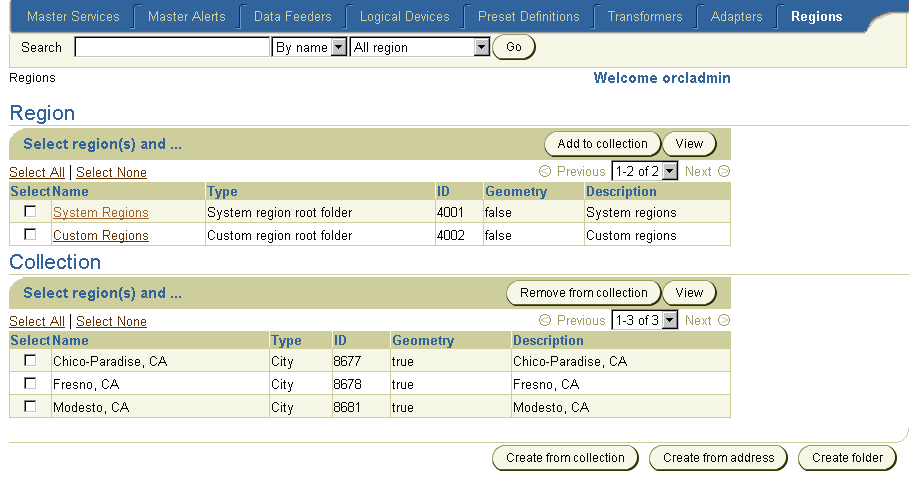
Text description of the illustration srv_breg.gif
The region modeling tool lets administrators of a wireless portal service create custom regions that can be associated with location-based services. When you create a service, if you specify that it is location dependent, you specify a region: either an Oracle-supplied system-defined region or a custom region previously created with the region modeling tool.
A region is simply a geographic entity, or location. A region can be small (such as a street address) or large (such as a country). A region can be represented by a point, as is often done for addresses and locations of interest (such as airports and museums), or by a polygon, as is usually done for states and countries. For detailed information about using the region modeling tool, click the Help button on modeling tool in the chapter on Location Services in the Oracle9iAS Developer's Guide.






















